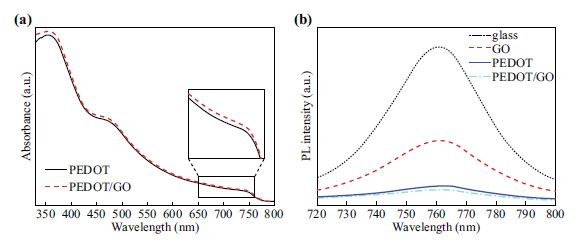Nano-Micro Letters ( IF 31.6 ) Pub Date : 2017-02-06 , DOI: 10.1007/s40820-017-0140-x Hui Luo , Xuanhuai Lin , Xian Hou , Likun Pan , Sumei Huang , Xiaohong Chen

|
As a hole transport layer (HTL), PEDOT:PSS usually limits the stability and efficiency of perovskite solar cells (PSCs) due to its hygroscopic nature and inability to block electrons. Here, a graphene oxide (GO)-modified PEDOT:PSS hole transport layer was fabricated by spin-coating a GO solution onto the PEDOT:PSS surface. PSCs fabricated on a GO-modified PEDOT:PSS layer exhibited a power conversion efficiency (PCE) of 15.34%, which is higher than 11.90% of PSCs with the PEDOT:PSS layer. Furthermore, the stability of the PSCs was significantly improved, with the PCE remaining at 83.5% of the initial PCE values after aging for 39 days in air. The hygroscopic PSS material at the PEDOT:PSS surface was partly removed during spin-coating with the GO solution, which improves the moisture resistance and decreases the contact barrier between the hole transport layer and perovskite layer. The scattered distribution of the GO at the PEDOT:PSS surface exhibits superior wettability, which helps to form a high-quality perovskite layer with better crystallinity and fewer pin-holes. Furthermore, the hole extraction selectivity of the GO further inhibits the carrier recombination at the interface between the perovskite and PEDOT:PSS layers. Therefore, the cooperative inter actions of these factors greatly improve the light absorption of the perovskite layer, the carrier transport and collection abilities of the PSCs, and especially the stability of the cells.
中文翻译:

石墨烯修饰的PEDOT:PSS空穴传输层上形成的高效且空气稳定的平面钙钛矿太阳能电池
作为空穴传输层(HTL),PEDOT:PSS由于其吸湿性和不能阻挡电子,通常会限制钙钛矿太阳能电池(PSC)的稳定性和效率。这里,克raphene氧化物(GO)改性PEDOT:PSS空穴传输层是通过旋涂制造 将溶液转到PEDOT:PSS表面。在GO改性PEDOT:PSS层上制造的PSC的功率转换效率(PCE)为15.34%,高于具有PEDOT:PSS层的PSC的11.90%。此外,PSC的稳定性显着提高,在空气中老化39天后,PCE保持在初始PCE值的83.5%。在GO溶液旋涂过程中,部分除去了PEDOT:PSS表面的吸湿PSS材料,从而提高了耐湿性并减少了空穴传输层与钙钛矿层之间的接触势垒。GO在PEDOT:PSS表面的分散分布显示出优异的润湿性,这有助于形成具有更好结晶度和更少针孔的高质量钙钛矿层。此外,GO的空穴提取选择性进一步抑制了钙钛矿与PEDOT:PSS层之间界面处的载流子复合。因此,这些因素的相互作用相互作用极大地改善了钙钛矿层的光吸收,PSC的载流子传输和收集能力,尤其是细胞的稳定性。


















































 京公网安备 11010802027423号
京公网安备 11010802027423号